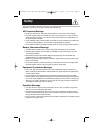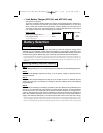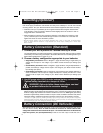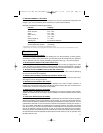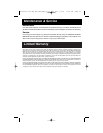
7
• Limit Battery Charger (APS 1012 and APS 2012 only)
(DIP Switch #4, Group B)
To prevent overheating smaller batteries, the charger on these UPS systems is initially set to
deliver only a fraction of its maximum power rating to connected batteries. If you are using
either of these APS systems with a larger battery or battery system (over 100 amp-hours at
12 volts for the APS 1012, over 200 amp-hours at 12 volts for the APS 2012), you may switch
your charger to full power without overheating your batteries.
Battery Charger Switch Position
Partial (1/3) Charging Power ........................Up*
Full Charging Power ....................................Down
* Factory default setting.
Battery Selection
Selecting Battery Type
Select a battery or system of batteries that will provide your APS with proper DC voltage and an
adequate amp hour capacity.* Select ‘Deep-Cycle’ batteries to enjoy optimum performance from
your APS.Batteries of either Wet-Cell (vented) or Gel-Cell/Absorbed Glass Mat (sealed) construction
are ideal. 6 Volt “golf-cart, Marine Deep-Cycle or 8D Deep-Cycle batteries are also acceptable.**
* Even though APS models are high-efficiency converters of electricity, their rated output capacities are limited by the amp-hour size
of the external batteries. ** You must set Configuration DIP Switch #1, Group A (Battery Type) to match the type of batteries you
connect or your batteries may be degraded or damaged over an extended period of time. See "APS Configuration," page 5 for more
information.)
Selecting Battery Amp Hour Capacity
Step 1:
Add the Wattage Ratings of your connected equipment to determine the Total Wattage Required.*
Step 2:
Divide the Total Wattage Required (from Step 1) by the battery voltage to determine the DC
Amperes Required.
Step 3:
Multiply the DC Amperes Required (from Step 2) by the number of hours you estimate will pass
without AC power before your battery can recharge to determine a Battery Amp-Hours Required
Rough Estimate.**
Step 4:
Compensate for inefficiency by multiplying your Battery Amp-Hour Required Rough Estimate (from
Step 3) by 1.2 to determine how many amp-hours of battery backup (from one or several batteries)
you should connect to your APS. Note that the Amp-Hour ratings of batteries are usually given for
a 20 hour discharge rate. Actual Amp-Hour capacities are less when batteries are discharged at
faster rates: batteries discharged in 55 minutes provide only about 50% of their listed Amp-Hour
ratings, while batteries discharged in 9 minutes provide as little as 30% of their Amp-Hour ratings.
* The wattage rating is usually stated in the equipment's manuals or on their nameplates. If your equipment is rated in amperes, convert
to watts by multiplying the ampere rating by your nominal AC line voltage (120). ** Your charging amps multiplied by the charging
hours must exceed the discharge amp-hours taken from the batteries between charges or you will eventually run down your battery bank.
1/3 Power*
Full
Power
44 33 22 11
200103046 120V APS MV-cabinetEn-Sp 93-1911.qxd 7/2/01 10:18 AM Page 7






